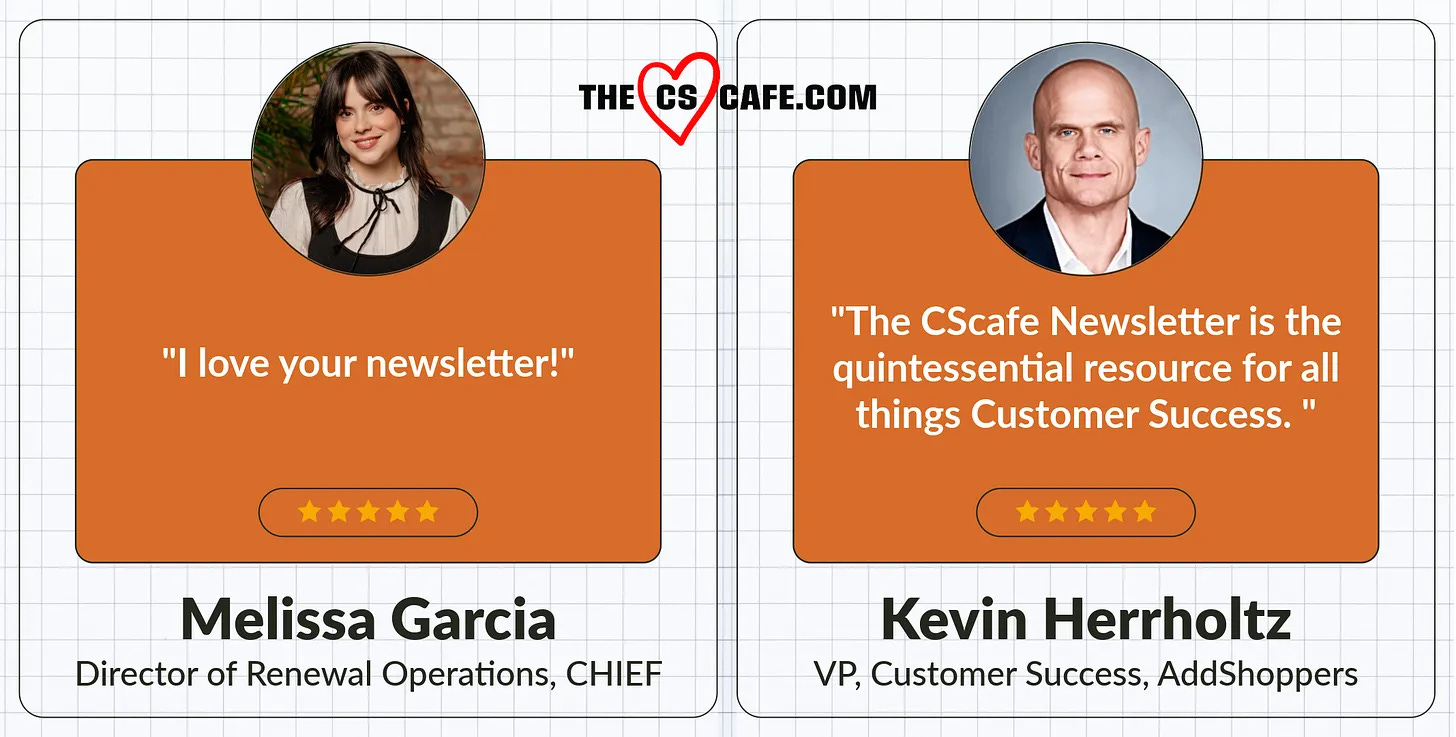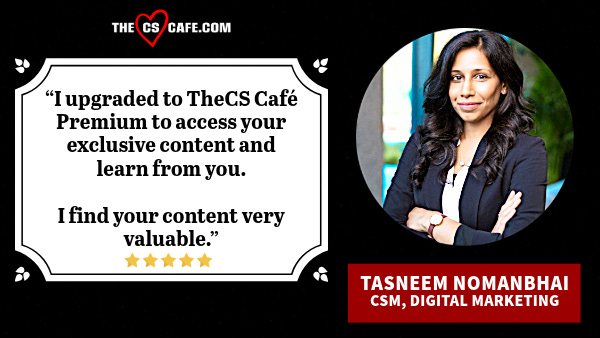With the rise of AI, Customer Success Managers (CSM) face a growing challenge:
How to engage active users without relying too much on automation?
Many turn to automated tools, hoping to scale their efforts.
But this approach often backfires, annoying the very customers they aim to support.
Here are smarter ways to connect and create meaningful interactions that resonate with your customers:
💡Check out my Customer Success Renewals & Upsells Strategy for tips on effective engagement strategies.
The Automation Trap
Many turn to tools like Intercom to automate customer interactions with chat boxes, banners, and surveys.
These can be effective for onboarding or re-engaging at-risk customers.
But active users often ignore or dismiss these interruptions.
According to Dr. Peter Fader, Professor of Marketing at the Wharton School:
"Automation can be a double-edged sword. While it scales engagement, it can also depersonalize the customer experience if not implemented thoughtfully."
In my interview with Kirsten DiChiappari, VP of Customer Success at vCom Solutions, she highlights the importance of balancing automation with personalization:
"If you can curate relevant insights and recommendations for your customers, packaged in an easily consumable, non-threatening way, you've won."
Understanding User Behavior
Active customers focus on their work and view unexpected pop-ups as distractions.
This presents a challenge for CSMs trying to maintain relationships or promote new offerings.
Research supports this view:
A study by the Nielsen Norman Group found that 70% of users view pop-ups as annoying.
Furthermore, 50% report that these chat boxes or pop-ups impact their opinion of the advertiser in a negative way.
The Value Proposition
The core issue often is not in the method of communication.
But in the perceived value of the interaction.
Customers today have high expectations for personalized experiences:
According to McKinsey, 71% of consumers expect companies to deliver personalized interactions.
Even more telling, 76% get frustrated when this personalization doesn't happen.
This data underscores the importance of delivering value in every customer interaction.
Melissa Garcia, Director of Renewal Operations at Chief, highlights this point in our CS My Way interview:
"Customers are primarily interested in their own KPIs, not ours. Understanding this starts with attentive listening, asking pertinent questions, and then articulating how our offering aligns with their goals."
Shifting the Approach
To engage active users, set up these strategies instead:
Personalize your outreach
Move away from automated mass messages to more personalized, human interactions.
Choose appropriate channels
Email or Slack may be more effective than in-app interruptions.
Focus on outcomes
Show how your software helps users achieve their goals.
Focus on high-touch engagement
For key accounts, invest in higher quality, more personalized interactions.
Jeanne Bliss, Customer Experience Pioneer, states:
"The most successful companies are those that make their customers more successful and simplify their lives."
💡Check my Time-Saving Tips for Customer Success & Productivity for more insights.
In my interview with Krystel Leal, Head Of Customer Success at OneText, also adds:
"Whenever I interact with my customers, I always check if they prefer to have meetings or if they'd rather communicate asynchronously. It's important not to impose our own working style or preferences on our customers."
💡Check out my "Ultimate Customer Success Plan Template: 14-Step Guide for SaaS & B2B" for an exclusive framework for personalizing customer interactions.
Segmentation and Targeting
One key aspect of effective engagement is proper segmentation and targeting.
Not all active users are the same, and a one-size-fits-all approach rarely works.
Segment your active users based on:
Usage patterns
Role within the organization
Industry vertical
Feature adoption rates
💡See my "Ultimate Customer Success Templates Collection" for more advanced segmentation strategies and templates.
A study published in the Journal of Marketing found that personalized marketing strategies can increase customer engagement by up to 20%.
Kirsten DiChiappari highlights the importance of segmentation:
"We also adjusted our customer health score to be calculated only based on a customer's consumption of our products and services. You can have a highly profitable customer who gives you a 10 on an NPS but still has a very low health score because they only use one thing you offer."
Read my full interview with Kirsten DiChiappari here.
Timing and Frequency
The timing and frequency of your engagements can impact their effectiveness.
Consider:
User activity cycles
Engage when users are most likely to be receptive, based on their usage patterns.
Optimal frequency
Find the right balance between staying top-of-mind and becoming a nuisance.
Contextual triggers
Reach out based on specific actions or milestones within the user's journey.
HubSpot reports that 33% of U.S. consumers have turned to social media at least once to complain about a bad experience with a brand.
This also highlights the importance of proactive, timely engagement.
Measuring Engagement Success
To improve your engagement strategies, it's fundamental to measure their effectiveness:
Track response rates
Track how often users interact with your engagements.
Analyze engagement quality
Look beyond simple clicks to assess the depth of interactions.
Measure impact on key metrics
Check how your engagement efforts affect retention, upsells, and customer satisfaction scores.
💡Check out my guide "7 Top SaaS Metrics Everyone Should Know" for a deep dive into important SaaS metrics and how to track them.
A study published in the Journal of the Academy of Marketing Science found there is a direct correlation between customer engagement behaviors influencing customer lifetime value and company performance.
Gillian Core, Former SVP of Customer Success at Placer, shares her approach in CS My Way:
"Our north star metric in CS is net revenue retention (NRR). If we are consistently striving to increase this number and measure all of our projects and initiatives against their impact on that goal, we focus our efforts on the right activities more often than not."
Read my full interview with Gillian Core here.
Key Takeaways
Effective customer engagement isn't about frequency or automation.
It’s about providing genuine value.
Understanding your users' needs and segmenting your audience is key.
Timing your interactions, and measuring your success will help you build stronger relationships with your active customer base.
Lincoln Murphy, the renowned Customer Success Strategist, says:
"Customer Success is about more than just reducing churn. It's about orchestrating the customer's journey toward their desired outcome."
And Jill Favro Sawatzky, Chief Customer Officer at Thought Industries, reinforces this idea in our interview :
"I'm responsible for ensuring that every interaction our customers have with our platform adds value to their experience."
Case Study: Personalization Success
To illustrate these principles in action, let's look at a brief case study
A SaaS company shifted from automated pop-ups to a targeted email campaign for their enterprise customers.
They segmented users based on feature adoption.
And started sending personalized tips and success stories.
Result:
They saw a 40% increase in engagement rates and a 25% boost in feature usage among inactive users.
This success aligns with broader industry trends.
According to Emarsys, increasing customer retention rates by just 5% can increase profits by 25% to 95%.
And That’s It: Level Up Your Customer Engagement
As you can see, effective customer engagement goes beyond automation.
It's about creating value, understanding your users, and delivering personalized experiences.
Implementing these strategies will help you transform your approach to customer success.
Even small changes can lead to significant improvements in engagement, and retention.
Don't wait to make a difference.
Choose one strategy from this edition and apply it to your customer success efforts this week.
Your customers - and your metrics - will thank you.
The future of customer success is personal, valuable, and measured.
Are you ready to lead the way?
-Hakan.
Read More on Customer Success Strategy
💡Check out my "Ultimate Customer Onboarding Template" and "Beyond KPIs: The Executive's Guide to Early Indicators and Predictive Analytics" for more in-depth resources and templates.
🔒 Premium Content
Advanced Guide to High-Quality Customer Engagement
Get access to my exclusive Advanced Guide to boost your customer engagement strategies.
This resource focuses on quality over quantity.
It will help you create meaningful interactions that drive long-term success:
Personalization at Scale
Learn advanced techniques to deliver highly personalized experiences without relying on intrusive automation.
Crafting High-Impact Touchpoints
Master the art of creating valuable, non-intrusive engagement points throughout the customer journey.
Advanced Segmentation for Targeted Engagement
Explore sophisticated segmentation strategies to ensure every interaction is relevant and timely.
Balancing Human Touch and Technology
Learn how to leverage technology to enhance, not replace, human interactions.
Case Studies in Quality Engagement
Get insights from in-depth analyses of companies that have prioritized quality over quantity in customer engagement.





